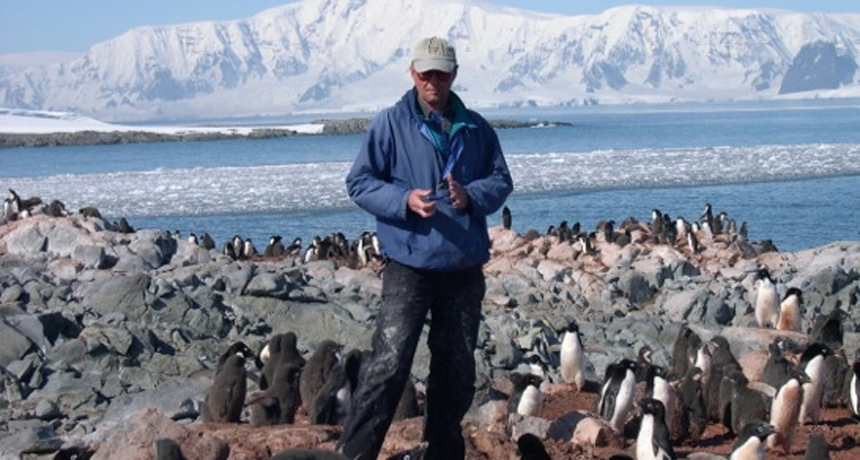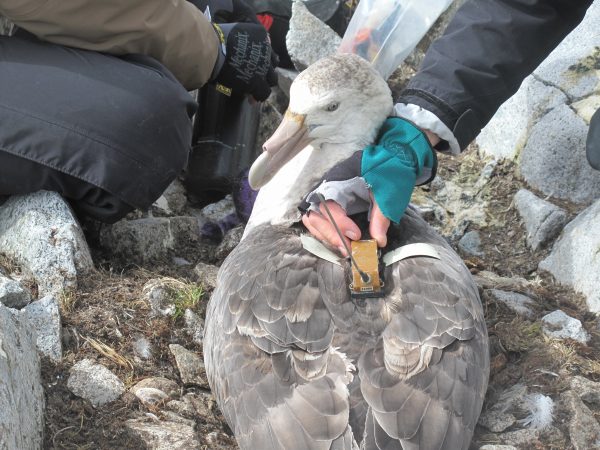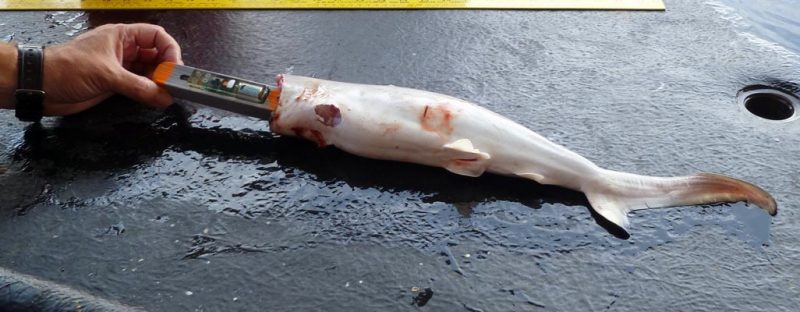Tag, you’re it!
Advances in radio and satellite tagging unveil the secret lives of animals

William Fraser on an island near Palmer Station on the Western Antarctic Peninsula. Through tagging, he and his team have been keeping a running census of Adelie penguins there.
Fen Montaigne
By Susan Moran
Maxwell Joseph wiped the sweat off his brow as he walked through a grassy field on a hot morning last July. Quiet as a mime, he was scouting for northern leopard frogs (Lithobates pipiens). Suddenly, an electronic chirping broke the silence. The radio receiver in his hands had picked up a signal from one of his subjects. “That’s 480,” Joseph whispered with a smile. “I’m calling her ‘Wily’ 480 because she’s sneaky.”
Joseph is doing research for his Ph.D. in ecology and evolutionary biology at the University of Colorado at Boulder. It’s just down the road. He knew he was homing in on Wily 480 thanks to a technology called telemetry.
The term combines the Greek roots tele, for far off, and metron, to measure. The technology has two parts. One is called a tag, or transmitter. The tag is attached to an animal. It then sends — or transmits — a signal at a certain selected radio frequency. It also assigns an individual code to each tagged animal. The second part, a receiver, scans for a signal using an antenna. It then homes in on the source and location of the transmissions it receives.
Advanced tags may relay signals very long distances, sometimes by bouncing them off of satellites. Another sort of tag records and stores data that scientists can download, once they recover the tag from the animal (or the waters around it).
On this summer’s day, Joseph walked upstream toward the chirping sound. The radio signal got louder as Joseph’s receiver neared Wily’s transmitter.

Homing in on Wily’s signal, Joseph finally spied the frog as she (yes, it’s a female) sprang from the water. He caught her. With her legs stretched out, this adult was longer than Joseph’s hand. Looking at her, he smiled affectionately. “She is pretty cute, isn’t she?”
Joseph is using radio tags to track the travels of local leopard frogs. It may help him better understand why their population has been dropping in recent years, and why in some places more than others. One known threat to leopard frogs as far away as Panama is a lethal chytrid (KIH trid) fungus known as Bd. That’s short for Batrachochytrium dendrobatidis (Buh TRAY ko KIT ree um DEN dro BAT ih dus).
Helped by tagging, Joseph and other scientists know that Wily and most other leopard frogs in this area of Colorado are fungus-free. But they will continue to track and test these amphibians to see if that trend changes.
Discovering the threats animals face is just one of many reasons why scientists tag wildlife.
“We’re dealing with animals, with predators, that spend much their lives in sort of obscurity,” notes William Fraser. He directs the Polar Oceans Research Group, based in Sheridan, Mont. “Tagging,” he explains, “was developed as an attempt to look into the secret lives of these animals.”

Tagging at the bottom of the world
Fraser has been studying penguins on Antarctica’s Western Peninsula for nearly 40 years. This region stretches like a crooked finger toward the tip of South America. To follow penguins (and some other seabirds), Fraser relies on tags. The technology helps because such animals often travel long distances to feed, sometimes even underwater.
At Fraser’s Antarctic field sites, global warming is advancing more rapidly than across the rest of the continent. Some scientists predict that if the region’s warming continues, seawater around the peninsula eventually may fail to freeze — even in winter. That could be tragic for penguins and other creatures that depend on sea ice cover for shelter or food. Among them: the shrimplike krill on which penguins dine. Especially when they are young, krill feed on algae that live on the underside of sea ice.
Fraser’s team has been tracking the health of Adelie, chinstrap and gentoo penguin populations by tagging the flightless birds and counting breeding pairs in their rookeries. He uses two types of tags. One is a satellite transmitter, which biologists attach to the birds’ lower backs with waterproof tape. The device transmits location data ¾the latitude and longitude of the tagged penguin ¾every few hours. Through a satellite link, those data get emailed to a computer in Fraser’s research lab. Other sensors on each tag measure water temperature, air temperature and pressure readings.
These scientists also use a second type of tag. Also a radio transmitter, it sends out a pulse that simply tells the biologists when the birds leave their nesting site and when they return. It may show, for instance, that an Adelie penguin left the rookery for 10 hours. This would suggest it took that long for the bird to stuff its belly.
By using both types of tags, Fraser and his team made a big discovery about 10 years ago. They showed that how long penguins forage is linked directly to how plentiful the nearby krill are. These tagging data also suggested that roughly every four or five years, the region’s krill population spikes.
That’s very useful information. In years when there are lots of krill, penguins spend less time foraging ¾six to eight hours, compared with 24 to 30 hours during other years. In years with extra krill, penguins produce more chicks. Those chicks also grow faster and stronger.
Up in the air
More recently, Fraser has gleaned some alarming news from satellite tags about another local bird: the southern giant petrel. With a wingspan of 1.8 meters (6 feet), these birds resemble huge gulls. From 1974 to 2000 their population along the Western Peninsula increased slowly but steadily. Their numbers peaked at roughly 600 breeding pairs in the summer of 2008 to 2009. Since then their numbers have been dropping. And, Fraser adds, “We’ve seen some crazy fluctuations.” In some years the local population may lose 150 breeding pairs — about one in every four breeding couples.
Fraser’s group attaches tags to a mat of feathers on the back of a petrel. Each device sends out data on its location about every six hours. Those data have shown the birds can travel up to 2,500 kilometers (1,553 miles) on a feeding trip.
Fraser and other scientists don’t yet know why petrel numbers are dropping, and particularly why their population swings dramatically from year to year, but they have a suspicion. And it’s not climate change.
Large boats have been arriving in droves to fish the waters around Antarctica. Some of the boats fish legally, others illegally. Together, they mostly target Patagonian toothfish. It’s a rather unattractive fish with an oddball name. To make it more appealing, fishers have taken to calling it Chilean seabass.
Fishing fleets catch these fish using several methods, including “long lines.” A long line is a cable that stretches as much as 16 kilometers (10 miles) along the ocean floor. Thousands of baited hooks span that length. Giant petrels apparently swoop down to feed on the bait while the fishing lines are being dropped into or retrieved from the deep waters. The birds also may scoop up hooked bait left behind on the ocean surface. The petrels probably figure they’re getting a free lunch. But some may get hooked and drown. Others manage to fly home with their injuries.
“We can’t prove it,” Fraser says. Still, he notes, “there isn’t a year that goes by that we don’t see giant petrels returning to their nests with hooks in their wings or embedded in their throats or other body parts.” Clearly, he concludes: “Something pretty violent is going on.”
Inside the bellies of sharks
Electronic tags help marine biologist Carl Meyer study another class of oceanic predators: sharks. Meyer works at the Hawaii Institute of Marine Biology on tiny Coconut Island, off the coast of Oahu. It is part of the University of Hawaii at Manoa. In a lagoon outside his lab there’s a large, rectangular mesh pen. It is filled with sharks, smaller fish and coral.

Meyer also wants to know what happens when sharks disappear.
For instance, he and other scientists have been probing the behavior of Hawaii’s tiger sharks for roughly 20 years. Tagging has revealed they can roam quite far. The predators switch back and forth between just hanging out in coastal waters and then zipping out into open ocean, sometimes hundreds, even thousands, of kilometers away from these islands. “We suspect that these complex patterns of movement are primarily driven by the need to feed and reproduce,” explains Meyer.
More recently, he has begun focusing on shark dining patterns. Currently, he points out, “We know almost nothing about how often sharks feed, where they are feeding, how much they consume, etc.”
Science News for Students visited him on a breezy September day to learn how he is using newer types of electronic tags. Called pop-up archival tags, these collect and store information until released from their host. In this case, the fish will regurgitate the device it had previously swallowed. Once freed, the tag will float on the ocean surface until someone travels by boat to fetch it. This may take a couple of weeks.
Measuring a shark’s digestion can prove challenging. The tag’s sensors measure how easily a tiny electric current can pass through the contents of the shark’s stomach. Whenever a shark eats, it swallows some seawater. At that point, the electric current will flow easily. But as the tissues of its meal (other fish, mostly) begin to break down, they will release fats. These make it difficult for the current to flow. By monitoring the electric current in the beast’s gut, the tags reveal to researchers like Meyer when and how often the sharks feed, and how much they digest at each meal.
This reporter followed Meyer outside his lab to watch him “feed” one of these tags to a sandbar shark. First he stuffed the grenade-shaped device into the 30-centimeter (12-inch) torso of a dead juvenile tiger shark. It looked like he was stuffing a Thanksgiving turkey, except backward, from the neck down. This was the bait. (Yes, sharks eat their own kind.) Then he attached the tasty morsel to a hooked fishing line and dropped it into the fenced-in pen. Before long, a sandbar shark came by and snapped it up.

He was able to identify feeding signals in the data. The signals don’t yet offer a detailed picture. But they confirm the value of using electric-current signals to map a shark’s feeding patterns. Eventually, such data should help Meyer advance his mission — to better understand the natural behavior of these animals.
With electric tags, Meyer and other scientists will continue to uncover more information about the hidden lives of wild animals. These findings will help people better understand the roles these animals play in their ecosystem — and how losing them could make that ecosystem unravel.
Power Words
amphibian Cold-blooded vertebrate animal of a class that includes frogs, toads, newts and salamanders. They are distinguished by having an aquatic gill-breathing larval stage typically followed by a terrestrial lung-breathing adult stage.
Antarctica A continent mostly covered in ice, which sits in the southernmost part of the world.
conservation The act of preserving or protecting the natural environment.
ecology A branch of biology that deals with the relations of organisms to one another and to their physical surroundings. A scientist who works in this field is called an ecologist.
ecosystem A group of interacting living organisms — including microorganisms, plants and animals — and their physical environment within a particular climate. Examples include tropical reefs, rainforests, alpine meadows and polar tundra.
evolutionary biology Studies of the adaptive processes that have led to the diversity of life on Earth. Scientists who work in this field are known as evolutionary biologists. They can study everything from the microbiology and genetics of living organisms, to how species change to adapt — even what the fossil record looks like (to assess how various ancient species are related to each other and to modern-day relatives).
forage To search for something, especially food.
frequency The number of times a specified periodic phenomenon occurs within a specified time interval. In physics, the number of wavelengths that occurs over a particular interval of time.
fungus (plural: fungi) Any of a group of unicellular or multicellular, spore-producing organisms that feed on organic matter, both living and decaying. Molds, yeast and mushrooms are all types of fungi.
GPS Abbreviation for global positioning system.
GPS device Devices that calculate their position (in terms of latitude and longitude) from any place on the ground or in the air. They do this by comparing how long it takes signals from different satellites to reach them.
habitat The area or natural environment in which an animal or plant normally lives, such as a desert, coral reef or freshwater lake. A habitat can be home to thousands of different species.
lichen A blend of a fungus and an alga. Neither of these organisms is a plant; the lichen isn’t a plant either.
marine Having to do with the ocean world or environment.
Ph.D. (also known as a doctorate) A type of advanced degree offered by universities — typically after five or six years of study — for work that creates new knowledge. People qualify to begin this type of graduate study only after having first completed a college degree (a program that typically takes four years of study).
plankton A small organism that drifts or floats in the sea. Depending on the species, plankton range from microscopic sizes to organisms about the size of a flea. Some are tiny animals. Others are plantlike organisms. Although individual plankton are very small, they form massive colonies, numbering in the billions. The largest animal in the world, the blue whale, lives on plankton.
predator (adjective: predatory) A creature that preys on other animals for most or all of its food.
prey Animal species eaten by others.
radio To send and receive radio waves; or the device that receives these transmissions.
radio tracking Following the movements of an animal or object using a device that gives off radio waves. A receiver can pick up those radio-frequency waves to provide information on how far away the broadcasting signal is and in which direction. Many biologists implant devices into animals that broadcast such radio-wave signals to keep track of the tagged individual in the wild.
radio waves Waves in a part of the electromagnetic spectrum; they are a type that people now use for long-distance communication. Longer than the waves of visible light, radio waves are used to transmit radio and television signals; radar also relies on these waves.
rookery A place where birds or animals, such as penguins and seals, nest or breed. The term stems from the word “rook,” which is an ancient bird that looks like the North American crow and nests in colonies near the tops of trees.
sensor A device that picks up information on physical or chemical conditions — such as temperature, barometric pressure, salinity, humidity, pH, light intensity or radiation — and stores or broadcasts that information. Scientists and engineers often rely on sensors to inform them of conditions that may change over time or that exist far from where a researcher can measure them directly.
telemetry A form of wireless communication in which measurements such as geographic location are collected, stored in a device and then transmitted to a receiver somewhere else.
Word find (click here to enlarge for printing)







